FluWatch report: October 14, 2018 to October 20, 2018 (Week 42)
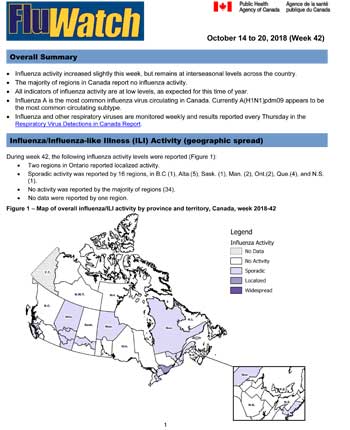
Download the alternative format
(PDF format, 815 KB, 7 pages)
Organization: Public Health Agency of Canada
Date published: 2018-10-26
Related Topics
Overall Summary
- Influenza activity increased slightly this week, but remains at interseasonal levels across the country.
- The majority of regions in Canada report no influenza activity.
- All indicators of influenza activity are at low levels, as expected for this time of year.
- Influenza A is the most common influenza virus circulating in Canada. Currently A(H1N1)pdm09 appears to be the most common circulating subtype.
- Influenza and other respiratory viruses are monitored weekly and results reported every Thursday in the Respiratory Virus Detections in Canada Report
On this page
- Influenza/ILI Activity (geographic spread)
- Laboratory Confirmed Influenza Detections
- Syndromic/Influenza-like Illness Surveillance
- Participatory Syndromic Surveillance
- Severe Outcomes Influenza Surveillance
- Influenza Strain Characterizations
- Antiviral Resistance
- Provincial and International Influenza Reports
Influenza/Influenza-like Illness Activity (geographic spread)
During week 42, the following influenza activity levels were reported (Figure 1):
- Two regions in Ontario reported localized activity.
- Sporadic activity was reported by 16 regions, in B.C (1), Alta.(5), Sask. (1), Man. (2), Ont.(2), Que.(4), and N.S. (1).
- No activity was reported by the majority of regions (34).
- No data were reported by one region.
Figure 1 – Map of overall influenza/ILI activity by province and territory, Canada, week 2018-42
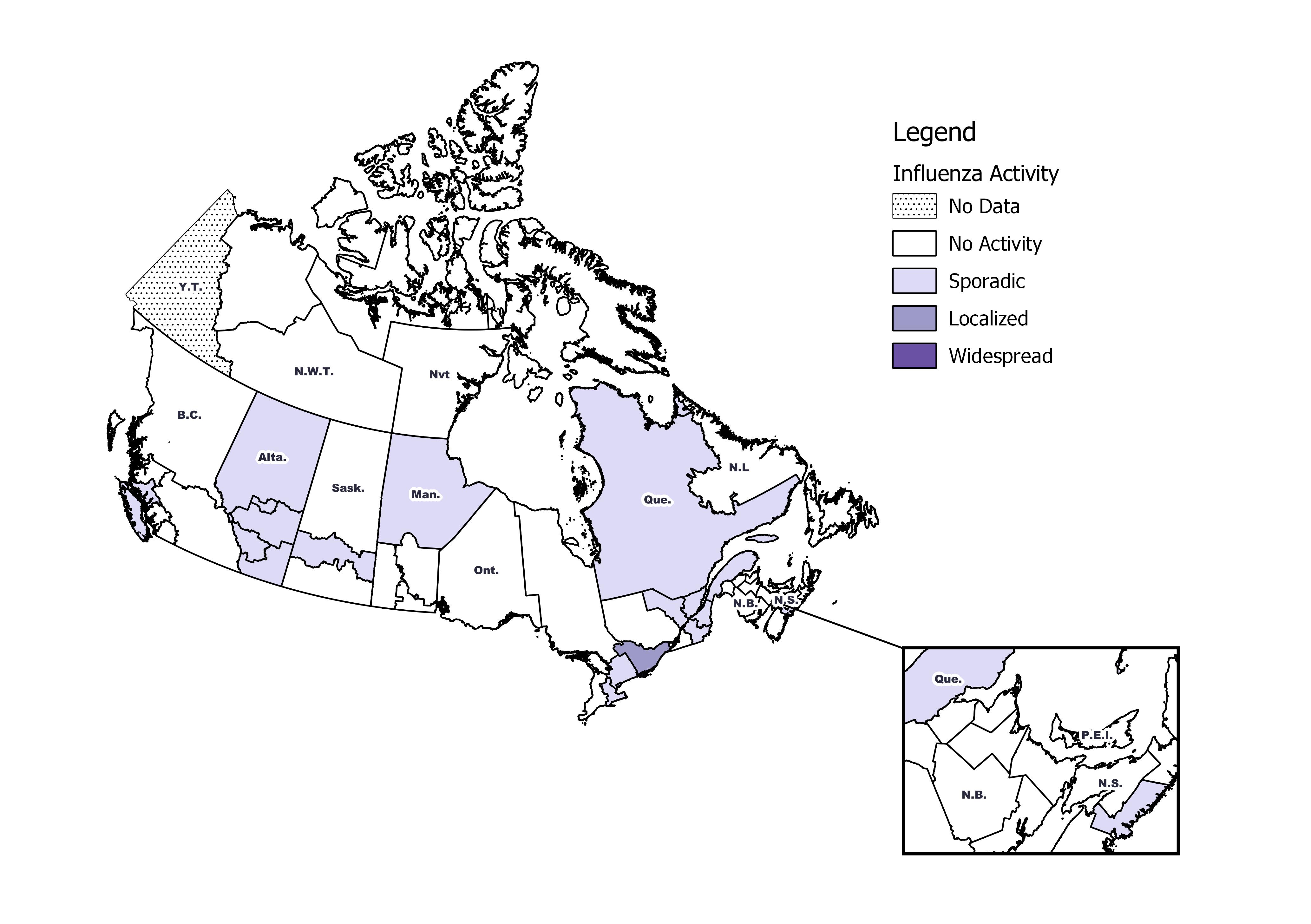
Figure 1 - Text Description
| Province | Influenza Surveillance Region | Activity Level |
|---|---|---|
| N.L. | Labrador-Grenfell | No Activity |
| N.L. | Central | No Activity |
| N.L. | Western | No Activity |
| P.E.I. | Prince Edward Island | No Activity |
| N.S. | Zone 1 - Western | No Activity |
| N.S. | Zone 2 - Northern | No Activity |
| N.S. | Zone 3 - Eastern | No Activity |
| N.S. | Zone 4 - Central | Sporadic |
| N.B. | Region 1 | No Activity |
| N.B. | Region 2 | No Activity |
| N.B. | Region 3 | No Activity |
| N.B. | Region 4 | No Activity |
| N.B. | Region 5 | No Activity |
| N.B. | Region 6 | No Activity |
| N.B. | Region 7 | No Activity |
| Que. | Nord-est | Sporadic |
| Que. | Québec et Chaudieres-Appalaches | Sporadic |
| Que. | Centre-du-Québec | Sporadic |
| Que. | Montréal et Laval | Sporadic |
| Que. | Ouest-du-Québec | No Activity |
| Que. | Montérégie | No Activity |
| Ont. | Central East | Sporadic |
| Ont. | Central West | Sporadic |
| Ont. | Eastern | Localized |
| Ont. | North East | No Activity |
| Ont. | North West | No Activity |
| Ont. | South West | No Activity |
| Ont. | Toronto | Localized |
| Man. | Northern Regional | Sporadic |
| Man. | Prairie Mountain | No Activity |
| Man. | Interlake-Eastern | No Activity |
| Man. | Winnipeg | Sporadic |
| Man. | Southern Health | No Activity |
| Sask. | North | No Activity |
| Sask. | Central | Sporadic |
| Sask. | South | No Activity |
| Alta. | North Zone | Sporadic |
| Alta. | Edmonton | Sporadic |
| Alta. | Central Zone | Sporadic |
| Alta. | Calgary | Sporadic |
| Alta. | South Zone | Sporadic |
| B.C. | Interior | No Activity |
| B.C. | Fraser | No Activity |
| B.C. | Vancouver Coastal | No Activity |
| B.C. | Vancouver Island | Sporadic |
| B.C. | Northern | No Activity |
| Y.T. | Yukon | No Data |
| N.W.T. | North | No Activity |
| N.W.T. | South | No Activity |
| Nvt. | Qikiqtaaluk | No Activity |
| Nvt. | Kivalliq | No Activity |
| Nvt. | Kitimeot | No Activity |
Laboratory Confirmed Influenza Detections
In week 42, the following results were reported from sentinel laboratories across Canada (Figure 2 and Figure 3):
- Laboratory detections of influenza are increasing, but remain below the seasonal threshold.
- A total of 105 laboratory detections of influenza were reported. All but one of these detections were influenza A.
- The percentage of tests positive for influenza was 3% in week 42.
To date this season 261 laboratory-confirmed influenza detections have been reported (Figure 3):
- 95% have been influenza A
- Among the 148 influenza A viruses subtyped, 67% have been A(H1N1)pdm09
To date this season, detailed information on age and type/subtype has been received for 217 laboratory-confirmed influenza cases (Table 1):
- Adults 20-64 years of age represent the largest proportion of cases (53%), followed by children 0-19 years of age (29%).
For more detailed weekly and cumulative influenza data, see the text descriptions for Figures 2 and 3 or the Respiratory Virus Detections in Canada Report.
Figure 2 – Number of positive influenza tests and percentage of tests positive, by type, subtype and report week, Canada, 2018-35 to 2018-42
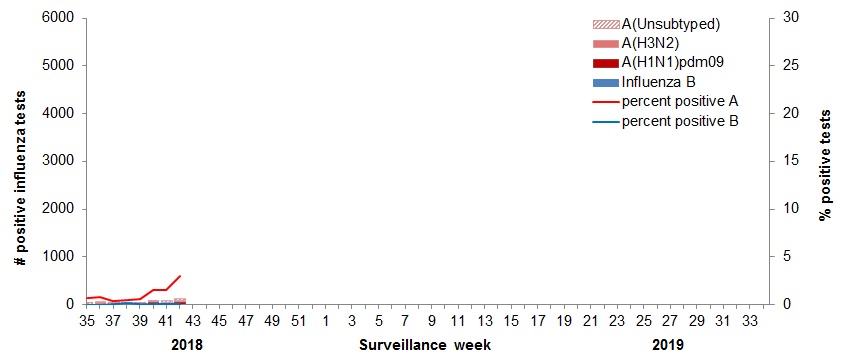
The shaded area indicates weeks where the positivity rate was at least 5% and a minimum of 15 positive tests were observed, signalling the start and end of seasonal influenza activity.
Figure 2 - Text Description
| Surveillance Week | A(Unsubtyped) | A(H3) | A(H1)pdm09 | Influenza B |
|---|---|---|---|---|
| 35 | 3 | 2 | 7 | 0 |
| 36 | 4 | 7 | 4 | 0 |
| 37 | 3 | 2 | 3 | 1 |
| 38 | 6 | 3 | 2 | 3 |
| 39 | 11 | 5 | 1 | 3 |
| 40 | 16 | 7 | 29 | 3 |
| 41 | 27 | 6 | 21 | 3 |
| 42 | 40 | 18 | 46 | 1 |
Figure 3 – Cumulative numbers of positive influenza specimens by type/subtype and province/territory, Canada, weeks 2018-35 to 2018-42
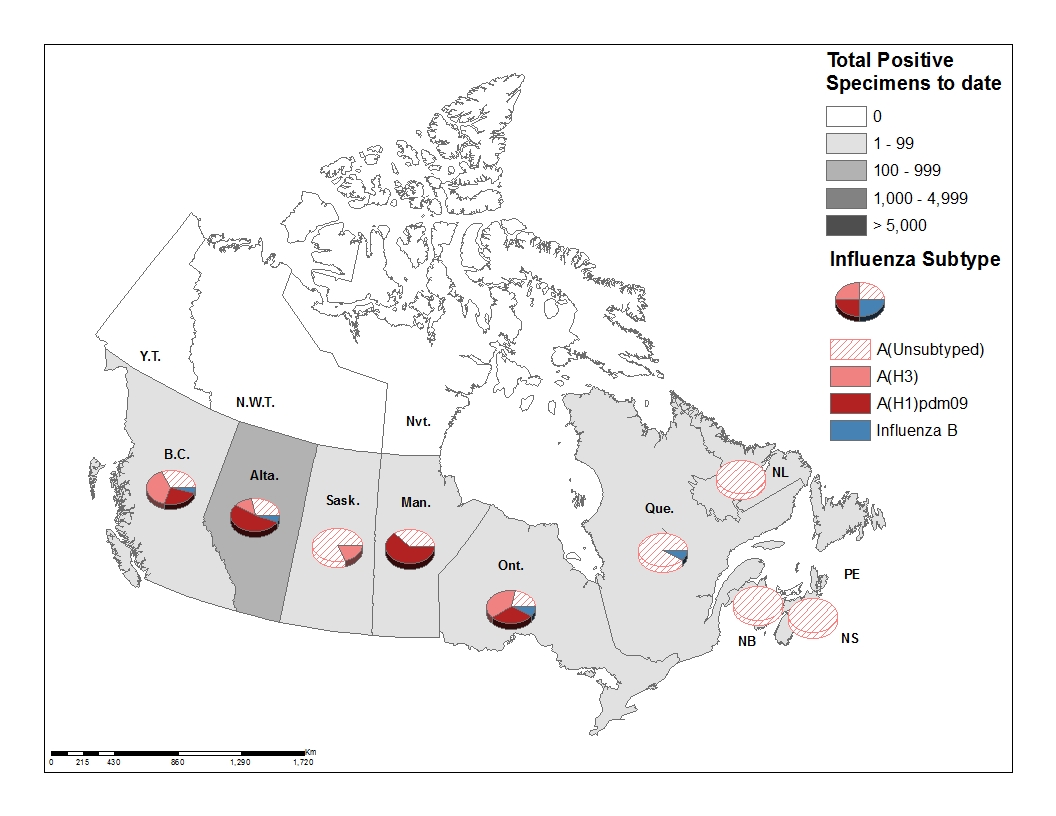
Figure 3 - Text Description
| Reporting provincesTable Figure 3 - Footnote 1 |
Week (October 14, 2018 to October 20, 2018) | Cumulative (August 26, 2018 to October 20, 2018) | |||||||||
|---|---|---|---|---|---|---|---|---|---|---|---|
| Influenza A | B | Influenza A | B | A & B Total |
|||||||
| A Total |
A (H1N1)pdm09 |
A (H3N2) |
A(UnS)Table Figure 3 - Footnote 3 | B Total |
A Total |
A (H1N1)pdm09 |
A (H3N2) |
A(UnS)Table Figure 3 - Footnote 3 | B Total |
||
| BC | 14 | 6 | 7 | 1 | 1 | 44 | 12 | 17 | 15 | 2 | 46 |
| AB | 51 | 30 | 4 | 17 | 0 | 116 | 65 | 16 | 35 | 7 | 123 |
| SK | 0 | 0 | 0 | 0 | 0 | 11 | 0 | 2 | 9 | 0 | 11 |
| MB | 11 | 5 | 0 | 6 | 0 | 16 | 10 | 0 | 6 | 0 | 16 |
| ON | 11 | 3 | 7 | 1 | 0 | 34 | 12 | 18 | 8 | 3 | 37 |
| QC | 9 | 0 | 0 | 9 | 0 | 22 | 0 | 0 | 22 | 2 | 24 |
| NB | 0 | 0 | 0 | 0 | 0 | 2 | 0 | 0 | 2 | 0 | 2 |
| NS | 1 | 0 | 0 | 1 | 0 | 1 | 0 | 0 | 1 | 0 | 1 |
| PEI | 0 | 0 | 0 | 0 | 0 | 0 | 0 | 0 | 0 | 0 | 0 |
| NL | 0 | 0 | 0 | 0 | 0 | 1 | 0 | 0 | 1 | 0 | 1 |
| YT | 0 | 0 | 0 | 0 | 0 | 0 | 0 | 0 | 0 | 0 | 0 |
| N.W.T | 0 | 0 | 0 | 0 | 0 | 0 | 0 | 0 | 0 | 0 | 0 |
| NU | 0 | 0 | 0 | 0 | 0 | 0 | 0 | 0 | 0 | 0 | 0 |
| Canada | 97 | 44 | 18 | 35 | 1 | 247 | 99 | 49 | 99 | 14 | 261 |
| PercentageTable Figure 3 - Footnote 2 | 99% | 45% | 19% | 36% | 1% | 95% | 40% | 20% | 40% | 5% | 100% |
Discrepancies in values in Figures 2 and 3 may be attributable to differing data sources. Cumulative data includes updates to previous weeks. |
|||||||||||
| Age groups (years) | Cumulative (August 26, 2018 to October 20, 2018) | ||||||
|---|---|---|---|---|---|---|---|
| Influenza A | B | Influenza A and B | |||||
| A Total | A(H1) pdm09 | A(H3) | A (UnS)Footnote 1 | Total | # | % | |
| 0-4 | >26 | 12 | <5 | 14 | 0 | x | 13% |
| 5-19 | >29 | 15 | <5 | 14 | <5 | x | 15% |
| 20-44 | 62 | 32 | 6 | 24 | <5 | x | 30% |
| 45-64 | 46 | 19 | 9 | 18 | <5 | x | 22% |
| 65+ | 37 | 14 | 10 | 13 | <5 | x | 19% |
| Total | 205 | 92 | >25 | 83 | x | >380 | 100% |
|
|||||||
Syndromic/Influenza-like Illness Surveillance
Healthcare Professionals Sentinel Syndromic Surveillance
In week 42, 1.6% of visits to healthcare professionals were due to influenza-like illness (ILI) (Figure 4). The percentage of visits for ILI is within expected levels.
Figure 4 - Percentage of visits for ILI reported by sentinels by report week, Canada, weeks 2018-35 to 2018-42
Number of Sentinels Reporting in Week 42: 91
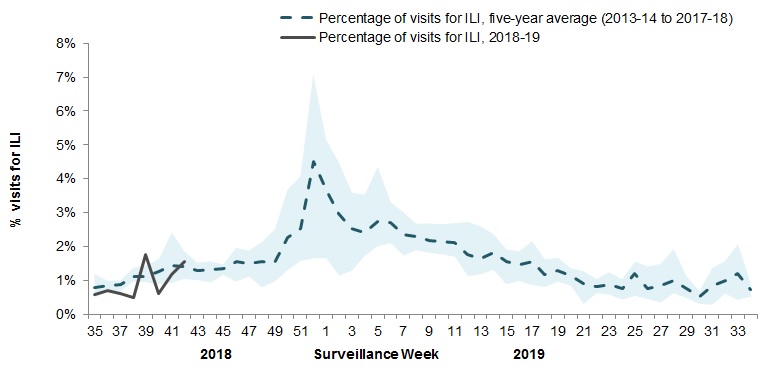
The shaded area represents the maximum and minimum percentage of visits for ILI reported by week from seasons 2013-14 to 2017-18
Figure 4 - Text Description
| Report week | 2018-19 | Average | Min | Max |
|---|---|---|---|---|
| 35 | 0.6% | 0.6% | 0.4% | 0.9% |
| 36 | 0.7% | 0.8% | 0.5% | 1.0% |
| 37 | 0.6% | 0.9% | 0.7% | 1.1% |
| 38 | 0.5% | 1.0% | 0.7% | 1.4% |
| 39 | 1.8% | 1.1% | 0.8% | 1.5% |
| 40 | 0.6% | 1.6% | 0.9% | 3.4% |
| 41 | 1.2% | 1.6% | 1.1% | 2.1% |
| 42 | 1.6% | 1.4% | 0.8% | 1.8% |
Participatory Syndromic Surveillance
In week 42, 1,944 participants reported to FluWatchers, of which 33 (1.7%) reported symptoms of cough and fever (Figure 5).
Among the 33 participants who reported fever and cough:
- 15% consulted a healthcare professional
- 94% reported days missed from work or school, resulting in a combined total of 61 missed days of work or school.
Figure 5 – Percentage of participants reporting cough and fever, Canada, week 2018-42
Number of Participants Reporting in Week 42: 1944
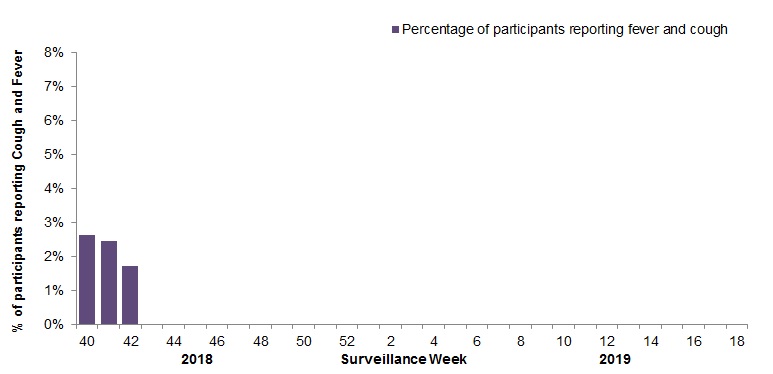
Figure 5 - Text Description
| Surveillance Week | % cough and Fever |
|---|---|
| 40 | 2.6% |
| 41 | 2.5% |
| 42 | 1.7% |
Influenza Outbreak Surveillance
In week 42, one new laboratory-confirmed influenza outbreak was reported in a long-term care facility, associated with influenza A(H3N2).
To date this season, 5 influenza outbreaks have been reported.
- Four outbreaks were in long-term care facilities and one was in a school.
- Four outbreaks were associated with influenza A (including both A(H1N1)pdm09 and A(H3N2)); the type was not available for the remaining one.
Two new ILI outbreaks were reported in week 42, one in a long-term care facility and one in a school.
To date this season, 19 ILI outbreaks have been reported; 18 occurred in LTC facilities, and one in a school.
Severe Outcomes Influenza Surveillance
Provincial/Territorial Influenza Hospitalizations and Deaths
To date this season, 24 influenza-associated hospitalizations were reported by participating provinces and territoriesFootnote 1.
- 92% were associated with influenza A
- An equal proportion of cases were reported in adults 20-64 years of age (33%) and adults 65 years of age and older (33%).
To date this season <5 ICU admissions and <5 deaths have been reported.
Pediatric Influenza Hospitalizations and Deaths
To date this season, five pediatric hospitalizations have been reported by the Immunization Monitoring Program Active (IMPACT) network. All cases have been associated with influenza A.
Adult Influenza Hospitalizations and Deaths
Surveillance of laboratory-confirmed influenza-associated adult (≥16 years of age) hospitalizations by the Canadian Immunization Research Network (CIRN) Serious Outcomes Surveillance (SOS) network has not yet begun for the 2018-19 season.
Influenza Strain Characterizations
Since September 1, 2018, the National Microbiology Laboratory (NML) has characterized 11 influenza viruses (2 A(H3N2) and 9 A(H1N1)) that were received from Canadian laboratories.
Genetic Characterization of Influenza A (H3N2):
One influenza A(H3N2) virus did not grow to sufficient hemagglutination titer for antigenic characterization by hemagglutination inhibition (HI) assay. Therefore, NML has performed genetic characterization to determine the genetic group identity of this virus.
Sequence analysis of the HA gene of this virus showed that:
- The A(H3N2) virus belonged to genetic group 3C.2a1
- A/Singapore/INFIMH-16-0019/2016-like virus belongs to genetic group 3C.2a1 and is the influenza A(H3N2) component of the 2018-19 Northern Hemisphere influenza vaccine
Antigenic Characterization:
Influenza A(H3N2):
- One influenza A(H3N2) virus was antigenically characterized as A/Singapore/INFIMH-16-0019/2016-like by HI testing using antiserum raised against egg-propagated A/Singapore/INFIMH-16-0019/2016.
- A/Singapore/INFIMH-16-0019/2016 is the influenza A(H3N2) component of the 2018-19 Northern Hemisphere influenza vaccine.
- The influenza A (H3N2) virus characterized belonged to genetic group 3C.2a1.
Influenza A(H1N1):
- Nine A(H1N1) viruses characterized were antigenically similar to A/Michigan/45/2015, which is the influenza A(H1N1) component of the 2018-19 Northern Hemisphere influenza vaccine.
Antiviral Resistance
Antiviral Resistance – Amantadine:
Eleven influenza A (2 A(H3N2) and 9 A(H1N1)) viruses were tested for resistance to amantadine and it was found that:
- The two A(H3N2) viruses tested were resistant to amantadine.
- The nine A(H1N1) virus tested were resistant to amantadine.
Antiviral Resistance – Oseltamivir:
Eleven influenza viruses (2 A(H3N2) and 9 A(H1N1)) were tested for resistance to oseltamivir and it was found that:
- The two A(H3N2) viruses tested were sensitive to oseltamivir
- The nine A(H1N1) viruses tested were sensitive to oseltamivir
Antiviral Resistance – Zanamivir:
Eleven influenza viruses (2 A(H3N2) and 9 A(H1N1)) were tested for resistance to zanamivir and it was found that:
- The two A(H3N2) viruses were sensitive to zanamivir.
- The nine A(H1N1) viruses were sensitive to zanamivir.
Provincial and International Surveillance Links
- Alberta – Influenza Surveillance
- British Columbia – Influenza Surveillance
- Manitoba - Seasonal Influenza Reports
- New Brunswick – Influenza Surveillance Reports
- Newfoundland and Labrador – Surveillance and Disease Reports
- Nova Scotia – Respiratory Watch Report
- Ontario – Ontario Respiratory Pathogen Bulletin
- Prince Edward Island – Influenza Summary
- Saskatchewan – Influenza Reports
- Québec – Sytème de surveillance de la grippe
- Australia – Influenza Surveillance Report and Activity Updates
- European Centre for Disease Prevention and Control - Surveillance reports and disease data on seasonal influenza
- New Zealand - Influenza Weekly Update
- United Kingdom - Weekly Influenza Activity Reports
- Pan-American Health Organization - Influenza Situation Report
- United States Centres for Disease Control and Prevention – Weekly Influenza Summary Update
- World Health Organization FluNet
Notes: To learn more about definitions, descriptions and the FluWatch program in general, see the Overview of influenza monitoring in Canada page. For more information on the flu, see our Flu(influenza) web page.
This report is available on the Government of Canada Influenza webpage.
Ce rapport est disponible dans les deux langues officielles.
We would like to thank all the Fluwatch surveillance partners who are participating in this year's influenza surveillance program.